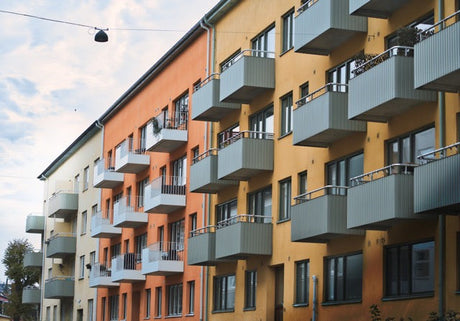In the UK, the design and installation of smoke shaft dampers is governed by a combination of British Standards and EU harmonised product standards.
BS EN 12101-8:2011
Title: Smoke and heat control systems – Part 8: Smoke control dampers.
- This is the harmonised European Standard that specifies requirements, test methods, and performance criteria for smoke control dampers.
- If a smoke damper is used in a smoke shaft system (typical in high-rise residential buildings), it must be CE/UKCA marked to BS EN 12101-8.
BS EN 1366 and Dampers
· 1. Fire Dampers
· BS EN 1366-2: Fire resistance tests for service installations – Part 2: Fire dampers
· This is the primary test standard for fire dampers (those designed to stop fire spread through ducts/walls).
· Tests the damper’s integrity (E) and, where relevant, insulation (I) when exposed to fire.
· Demonstrates how long the damper can prevent fire/smoke spread (e.g. E120, EI60).
· 2. Smoke Control Dampers
· BS EN 1366-10: Fire resistance tests for service installations – Part 10: Smoke control dampers
· This applies to dampers used in smoke control systems, e.g. those in smoke shafts in HRBs.
Tests for:
· Integrity (E)
· Insulation (I)
· Smoke leakage (S) at ambient and elevated temps
· Reliability (C) — cycling (open/close up to 10,000 times)
· Response to pressure (Pa) — e.g. 1500 Pa to simulate shaft pressures
· 3. How this links to BS EN 12101-8
· BS EN 12101-8 is the product standard for smoke control dampers.
· To get CE/UKCA marking to BS EN 12101-8, a damper must be tested to BS EN 1366-10.
In other words:
· 1366 = test standards (lab performance evidence)
· 12101-8 = product standard (design, certification, marking)
· 4. Fire vs Smoke Dampers in practice
· Fire damper: Tested to EN 1366-2, CE-marked to EN 15650.
· Smoke control damper: Tested to EN 1366-10, CE/UKCA-marked to EN 12101-8.
✅ In summary:
· The BS EN 1366 series provides the fire resistance test methods that underpin the certification of dampers.
· Fire dampers → EN 1366-2 → EN 15650 product standard
· Smoke control dampers → EN 1366-10 → EN 12101-8 product standard
Other relevant design standards/guidance:
- BS EN 12101 series – covers the wider smoke and heat control system (fans, ducts, dampers, control panels).
- BS 9999:2017 – provides fire safety management and design guidance, including smoke shafts.
- BS 9991:2015 – specifically for fire safety in residential buildings, including high-rise smoke control systems.
- Building Regulations Approved Document B (ADB) – sets out the functional fire safety requirements; smoke control systems (including dampers) must meet these requirements, often by following the BS EN 12101 route.
- CIBSE Guide E and SCA (Smoke Control Association) guidance – practical design/installation advice.
👉 In short:
For installation of smoke shaft dampers, the mandatory design/product standard is BS EN 12101-8, with Approved Document B and BS 9991/9999 guiding how and where they are applied in buildings.
Regulatory Reform (Fire Safety) Order 2005 requires that all fire safety equipment (including smoke control systems and their dampers) be kept in efficient working order and tested/maintained regularly.
- BS 9999:2017 (Fire safety in the design, management and use of buildings) and BS EN 12101 series (for smoke control systems) give more detailed recommendations.
- Typical inspection/testing frequencies used in practice:
- Visual inspection: At least once a month for control panels, indicators, and accessible parts of the system.
- Functional testing of smoke control dampers: At least once a year (often recommended every 6 months in HRBs due to higher risk). This involves checking that each damper opens/closes as intended, with proper feedback to the control system.
- Comprehensive servicing: Annually by a competent contractor.
- Grenfell-related regulatory changes: For HRBs (18m+ or 7+ storeys), the Fire Safety (England) Regulations 2022 require responsible persons to carry out monthly checks of lifts and essential firefighting equipment — while this doesn’t name dampers explicitly, smoke control systems fall within “essential equipment” in most fire risk assessments.
👉 So in practice:
- Check (visual/indicator tests) – monthly.
- Full functional test of dampers – every 6–12 months, depending on the building’s risk assessment.
Certification & Marking Requirements
1. CE / UKCA Marking
- All smoke control dampers placed on the UK market must be third-party tested and certified to BS EN 12101-8:2011.
- They must carry either:
- UKCA mark (for products sold in Great Britain), or
- CE mark (still recognised in Northern Ireland, and currently accepted in GB during the transition period).
2. Declaration of Performance (DoP)
-
Manufacturers must provide a DoP document with each damper, showing:
- Standard tested to (BS EN 12101-8).
- Performance results (fire resistance, leakage class, reliability, response time).
- Intended use (e.g. in smoke shafts).
3. Fire Resistance Classification (tested to BS EN 1366-10)
- Dampers must demonstrate integrity (E), insulation (I), and smoke leakage (S) performance.
- Marking example: E600 (ve ho i ↔) S1500 C10000 AA multi
- E600 = 600°C integrity
- S1500 = smoke leakage tested at 1500 Pa
- C10000 = 10,000 open/close cycles tested
- AA = actuator classification (fire safe in fail-safe position)
4. Third-Party Certification (UK best practice)
- Beyond CE/UKCA, regulators and insurers often expect independent certification schemes (e.g. BSI Kitemark, IFC Certification, Warringtonfire CERTIFIRE).
- This confirms that:
- The product was tested by an accredited lab.
- Ongoing audits are done on factory production control.
5. Installation Certification
- Dampers must be installed exactly as tested (e.g. wall type, orientation, fixings).
- Approved installers often issue an installation certificate to demonstrate compliance with BS EN 12101-8 and Building Regulations.
✅ In summary:
A compliant smoke shaft damper in the UK must be:
- Tested to BS EN 12101-8 and BS EN 1366-10.
- Carry CE/UKCA marking with a valid Declaration of Performance.
- Show a full fire resistance classification (E, I, S, C ratings).
- Preferably hold third-party certification (CERTIFIRE, IFC, etc.).
- Installed in line with the tested configuration and signed off by a competent contractor.
🔹 Fire Dampers vs Smoke Control Dampers (UK/EU Standards)
| Feature | Fire Dampers | Smoke Control Dampers |
| Purpose | Stop fire and smoke spreading through ducts/walls | Control smoke movement (e.g. smoke shafts, extract systems) |
| Test Standard | BS EN 1366-2: Fire resistance tests for fire dampers | BS EN 1366-10: Fire resistance tests for smoke control dampers |
| Product Standard | BS EN 15650: Ventilation for buildings – Fire dampers | BS EN 12101-8: Smoke and heat control systems – Smoke control dampers |
| Marking | CE / UKCA to EN 15650 | CE / UKCA to EN 12101-8 |
| Key Performance Criteria | Integrity (E), Insulation (I) | Integrity (E), Insulation (I), Smoke Leakage (S), Reliability (C – cycling), Pressure resistance (Pa) |
| Typical Classification | e.g. E120 or EI60 | e.g. E600 (ve ho i↔) S1500 C10000 AA multi |
| Where Used | In ducts/walls to maintain fire compartmentation | In smoke shafts, smoke extraction, pressurisation, and smoke containment systems |
| Regulatory Basis | Building Regulations (ADB), BS 9999, BS 9991 | Building Regulations (ADB), BS 9999, BS 9991, SCA guidance |
Compliance Flowchart for Dampers in High-Rise Buildings (HRBs)
This flowchart summarises the compliance pathway for fire dampers and smoke control dampers in high-rise buildings (HRBs), from initial design through to maintenance. It aligns with key UK regulations and standards including the Building Regulations (ADB), BS 9991, BS 9999, BS EN 1366 series, BS EN 15650, and BS EN 12101-8.

Key Stages:
1. Design Stage: Based on BS 9991 / BS 9999 / ADB requirements.
2. Testing: Fire dampers tested to BS EN 1366-2; Smoke control dampers tested to BS EN 1366-10.
3. Product Standards: Fire dampers → BS EN 15650; Smoke control dampers → BS EN 12101-8.
4. Certification & Marking: CE/UKCA marking, Declaration of Performance, and third-party approval.
5. Installation: Must follow tested configuration and be signed off by a competent contractor.
6. Maintenance: Monthly visual checks, 6–12 month functional tests, records maintained under RRO 2005.


